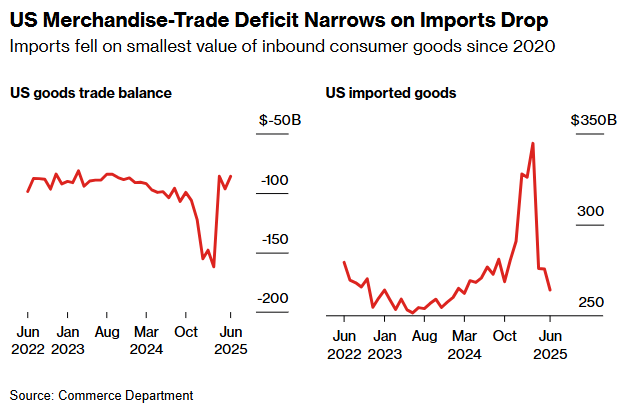Tariff Stockpiling Tide Recedes! US June Goods Imports Plummet, Trade Deficit Narrows or Boosts Q2 GDP
According to our sources, the US trade deficit in goods shrank more than expected in June, reflecting a decline in purchasing ahead of President Trump's tariffs taking effect. The import volume showed a general downward trend. The Commerce Department released data on Tuesday showing that the unadjusted trade deficit in goods narrowed by 10.8% from last month to $860 billion, which is below all predictions made by economists.
Specifically, June imports fell 4.2% to $2642 billion, with consumer goods imports at their lowest level since September 2020 and industrial supplies imports reaching a new low in 2021. Motor vehicle imports also showed a decline. Meanwhile, US exports of goods decreased by 0.6% during the same period.

These data will provide a basis for economists to estimate the contribution of net exports to Q2 GDP growth, with trade imbalances potentially improving significantly in the second quarter. In the first quarter this year, US businesses rapidly increased imports ahead of President Trump's tariffs taking effect, resulting in a reduction of 4.61 percentage points in the net export ratio and directly dragging down economic growth by 0.5% year-on-year.
Before the latest trade data was released, the Atlanta Fed's GDPNow model predicted that US economic growth would increase by 2.4% from April to June, with net exports expected to contribute 3.31 percentage points. In addition to goods trade data, the latest economic indicator report shows that retail inventory growth increased by 0.3%, the largest in September since last year, mainly driven by a surge in car dealership inventories; wholesale inventory growth increased by 0.2%.
The Trump administration's frequent adjustments to tariff policies continue to create uncertainty for manufacturers, although some trade partners have already reached agreements. However, there are still countries that need to reach an agreement with the US before Friday's deadline, or they will face a significant risk of tariffs increasing.
The Trump administration views tariffs as a key strategy to stimulate domestic production, boost exports, reduce trade deficits, increase fiscal revenue, and strengthen national security. It's worth noting that the complete June trade data (including service sector account balance) will be officially released on August 5.
